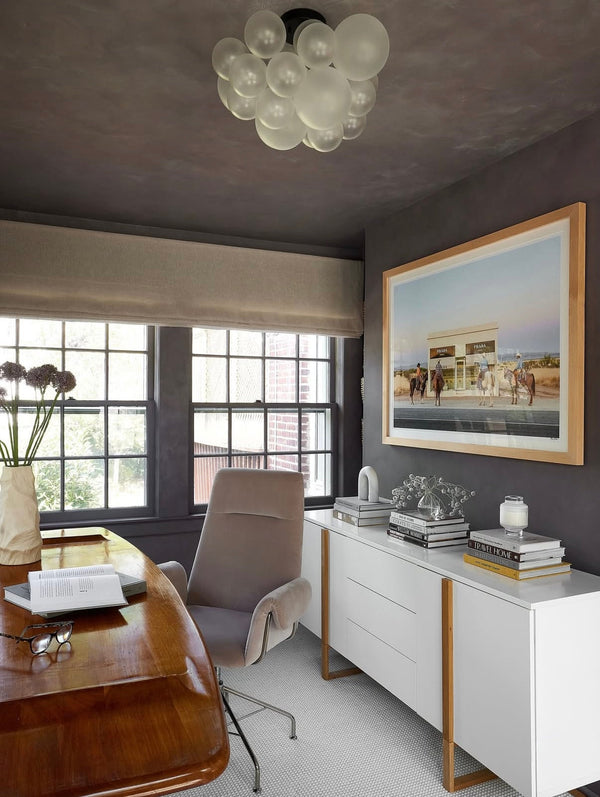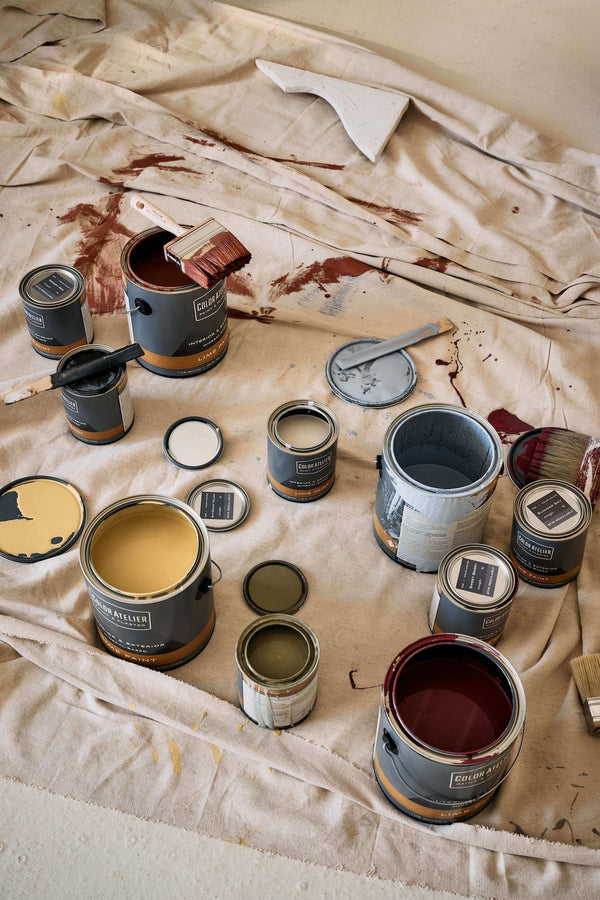What is Lime Paint?
Lime paint, sometimes referred to as limewash paint, is a centuries-old natural finish made from crushed limestone. When mixed with water and natural pigments, it creates a matte, mineral-rich coating that absorbs into surfaces rather than forming a film. This gives walls a soft, cloud-like movement that cannot be replicated by conventional acrylic paints.
At Color Atelier, our lime paints are designed not only for their historical authenticity but also for their ability to bring modern spaces to life with depth, texture, and eco-conscious beauty.

Product: Color Atelier Limewash, Plateau | Limewash Artisan: Red Poppy Paint
Interior Designer: Marina Hanisch | Photographer: Marco Ricca
A Short History of Lime Paint
Lime paint has been used for thousands of years in architecture, from ancient Roman villas to rustic European farmhouses. Historically, it was valued for its natural antibacterial properties and ability to let walls "breathe," preventing trapped moisture.
Today, this traditional paint has resurfaced in modern interior design as a sustainable alternative that offers both aesthetic elegance and practical benefits. Homeowners, designers, and renovators are once again turning to lime paint to create walls that feel alive.
What is Lime Paint Made Of?
Unlike synthetic paints that rely on plastic-based resins, lime paint is entirely mineral-based. It contains:
-
Lime (calcium hydroxide): The primary mineral component.
-
Natural pigments: Provide color with earthen dyes.
-
Water: Acts as the binder until it cures into a stone-like finish.
This unique composition means that a benefit of lime paint is that it is VOC-free, non-toxic, breathable, and naturally mold-resistant. It’s a healthier choice for your home and the environment.
Explore Color Atelier’s eco-friendly lime paints.
Lime Paint vs. Limewash: What’s the Difference?
The terms are often used interchangeably, but there is a slight distinction:
-
Lime paint has a thicker consistency and offers greater coverage
-
Limewash is more translucent and requires multiple coats for color build-up
Nonetheless, limewashing is commonly described as the process of applying the lime paint product to the walls using a brush with multi-directional strokes or a crosshatch pattern, which is why you will often hear the phrase "limewash painting."
When we talk about "lime wash", particularly in the context of interior spaces, we are generally referring to lime painting. Technically, our intention is not to "wash" the walls with a thin layer of colored lime (which is what is meant by "limewash" or "lime wash"); rather, we desire a gently textured, hand-brushed lime paint in a rich, sophisticated, or natural hue. Nevertheless, these terms are frequently used interchangeably, leading to some confusion.
At Color Atelier, our lime paints are formulated to offer the beauty of traditional limewash with the versatility modern interiors demand. Whether you want a subtle, cloud-like texture or a dramatic, layered look, we offer solutions for every style.
For most primed drywall applications, we use the lime paint product as is, without diluting it, however, on surfaces like bricks, stones, and concrete; adding water will achieve a more translucent finish for a softer washed look, if desired. Also, please make sure that the lime paint is stirred well, as a natural product, settling happens in the bottom of the containers. Note some darker colors can be thicker vs. lighter colors due to the amount of pigments added.

Product: Color Atelier Limewash, St Remy 150% 1st coat + 100% 2nd coat | Limewash Artisan: Fine Arts Finishes House
Interior Designer: Brianna Scott | Photographer: Lena Yaremenko
The Benefits of Using Lime Paint in Modern Interiors
Lime paint isn’t just about looks—it delivers functional advantages, too:
-
Natural & eco-friendly: 100% mineral-based and VOC-free.
-
Breathable finish: Prevents moisture buildup, making it ideal for older homes and high-humidity spaces.
-
Organic texture: Creates depth and movement, giving walls a sophisticated patina.
-
Naturally mold-resistant: Thanks to its high alkalinity.
These qualities make lime paint a favorite for designers and homeowners who want walls that are as healthy as they are beautiful.
Where Can You Use Lime Paint?
Lime paint can be used in many areas of the home, including:
-
Living rooms and bedrooms: Create serene, textured backdrops.
-
Bathrooms: When sealed with Color Atelier’s Sealers, lime painted walls and ceilings resist humidity and add spa-like elegance in bathrooms. For walls with direct water exposure, such as those in showers, Tadelakt plaster is the appropriate finish, as Lime Paint is not suitable for such conditions.
-
Kitchens: Perfect for kitchens with its soft, velvety, hand-crafted aesthetic. Apply Color Atelier’s Sealers as protective topcoat in high traffic areas to make the walls wipeable.
-
Exterior masonry or plaster: Adds old-world charm while protecting the surface.
If you’re unsure whether a surface is suitable, our team can help you determine the best preparation and finish.
Browse our limewash inspiration gallery to see how our customers have transformed their spaces.
How to Apply Lime Paint Properly
Applying lime paint is simpler than you might think:
-
Prepare the surface: Clean thoroughly and, if necessary, apply Color Atelier’s Mineral Primer.
-
Choose the right tools: A wide, natural-bristle brush is ideal for creating the signature textured effect. Color Atelier’s 5” block brush is the most ideal for most interior projects.
-
Apply in layers: Start with a thin coat, allow it to dry, then add additional coats for depth and movement.
-
Optional sealing: In high-traffic or high-moisture areas, apply Color Atelier’s protective wax or sealers.
For a detailed step-by-step guide, visit our lime paint how-to application page.
How to Maintain Lime Painted Walls
Maintaining lime-painted walls is straightforward:
-
Cleaning: Use a soft, dry cloth for dusting.
-
Touch-ups: Simply reapply a thin coat if needed—lime paint blends seamlessly.
-
Longevity: With minimal maintenance, lime paint develops a beautiful patina that improves over time.
Lime Paint FAQs
Can you use lime paint in bathrooms?
Yes, as long as it’s properly sealed in areas with high moisture.
Is lime paint DIY-friendly?
Absolutely! Many homeowners achieve stunning results with just a brush and some patience.
Will lime paint cover imperfections?
Yes, its soft, matte finish can help minimize surface flaws while adding texture.
What makes lime paint eco-friendly?
It’s mineral-based, VOC-free, and naturally purifies the air as it cures.
Can lime paint be used over drywall?
Yes, with proper priming, lime paint works beautifully over drywall.
Bring Timeless Texture to Your Home
Lime paint is more than just a finish—it’s an experience. Its breathable, eco-friendly nature and rich visual depth make it the perfect choice for anyone seeking a sophisticated, organic look for their walls.
Explore our Lime Paint Collection and discover the transformative power of Color Atelier’s finishes. Or contact us today to request samples and start your project with confidence.





